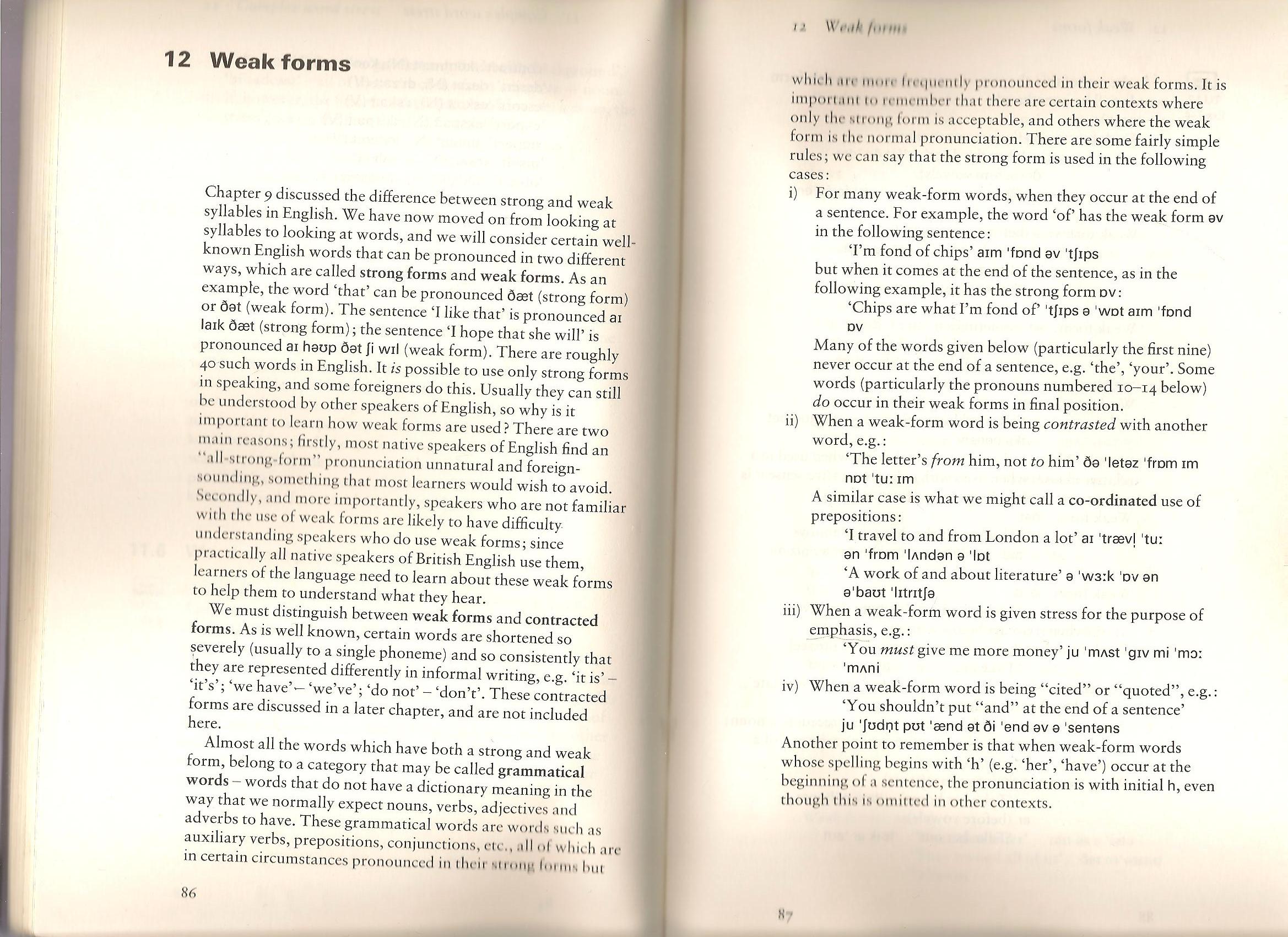roach

12 Weak forms
Chapter 9 discussed the difference between strong and weak syllables in English. We have now moved on from looking at syllables to looking at words, and we will consider certain well-known English words that can be pronounced in two different ways, which are called strong forms and weak forms. As an example, the word ‘that’ can be pronounced óaet (strong form) or Ó8t (weak form). The sentcnce ‘I like that’ is pronounced ai laik óaet (strong form); the sentence ‘I hope that she will’ is pronounced ai haup óet Ji wil (weak form). There are roughly 40 such words in English. It is possible to use only strong forms in speaking, and some foreigners do this. Usually they can still be understood by other speakers of English, so why is it import ant to learn how weak forms are used? There are two main rcasons; firstly, most native speakers of English find an ".111 sirong łonu” pronunciation unnatural and foreign-souiuling, soinething that most learners would wish to avoid.
Si a i mdły, and morę importantly, speakers who are not familiar willi ihe use <>f weak forms are likely to have difficulty imderstanding speakers who do use weak forms; sińce practically all native speakers of British English use them, learners of the language need to learn about these weak forms to help them to understand what they hear.
We must distinguish between weak forms and contracted forms. As is well known, certain words are shortened so severeły (usually to a single phoneme) and so consistently that they are represented differently in informal writing, e.g. ‘it is’ -‘it’s’; ‘we have’ — ‘we’ve’; ‘do not’ - ‘don’t’. These contracted forms are discussed in a later chapter, and are not included here.
Almost all the words which have both a strong and weak form, belong to a category that may be called grammatical words - words that do not have a dictionary meaning in the way that we normally expect nouns, verbs, adjectives and adverbs to have. These grammatical words are words such as auxiliary verbs, prepositions, conjunctions, eu all "I which are in certain circumstances pronounced in t lir 11 •amii|- h»im . Imi
wliu li ii i ....... Ii< i |ii« 1111 y pronounced in their weak forms. It is
iinpori.ini i«• u nu inlu i ili.u there are certain contexts where only i Ik mkmg form is acceptable, and others where the weak form is i lic normal pronunciation. There are some fairly simple rules; we can say that the strong form is used in the following cases:
i) For many weak-form words, when they occur at the end of a sentence. For example, the word ‘of’ has the weak form av in the following sentence:
‘I’m fond of chips’ aim 'fond ev 'tjips but when it comes at the end of the sentence, as in the following example, it has the strong form dv:
‘Chips are what I’m fond of’ 'tjips 0 'wot aim 'fond
DV
Many of the words given below (particularly the first nine) never occur at the end of a sentence, e.g. ‘the’, ‘your’. Some words (particularly the pronouns numbered 10-14 below) do occur in their weak forms in finał position.
ii) When a weak-form word is being contrasted with another word, e.g.:
‘The letter’s from him, not to him’ 60 1 let0Z 'from im not 'tu: im
A similar case is what we might cali a co-ordinated use of prepositions:
‘I travel to and from London a lot’ ai 'traevl 'tu: on 'fram 'lAndan 0 'lot
‘A work of and about literaturę’ 0 'W3:k 'ov 0n 0'baut 'litritj©
iii) When a weak-form word is given stress for the purpose of emphasis, e.g.:
‘You must give me morę money’ ju 'mASt 'giv mi 'mo: 'rmni
iv) When a weak-form word is being “cited” or “ąuoted”, e.g.:
‘You shouldnT put “and” at the end of a sentence’ ju 'Jodrnt pot 'aend 0t ói 'end 9v 0 'sent0ns Another point to remember is that when weak-form words whose spelling begins with ‘h’ (e.g. ‘her’, ‘have’) occur at the beginning ol .1 sentence, the pronunciation is with initial h, even though this is oinitled in ot her contexts.
H
Wyszukiwarka
Podobne podstrony:
UHAM014 About this book In the first chapter, the differences between headaches and migraines are ou
essent?rving?05 CHAPTER 1TOOLS AND EQUIPMENT The Differences between Carving and Carpentry Chis
cw0032 UNITAdvertising D4® 31 Listen to the difference between /au/and /au/. /su/ as in go slow no&n
PRZEDMIOTOWE EFEKTY KSZTAŁCENIA Z zakresu wiedzy: PEK_W01 Knows the difference between management an
cięta 7/17/2009 2:16 Strc 143 The differences between PR and a propaganda constitu
World History Semester 2 Finał Exam Study Guide Africa What are the differences between a developed
50770 New Forms Taschen 154 the lines between art and architecture, Richard Meier replies, "No.
When comparing and contrasting the similarities and differences between bridges and switches, which
4 LISTENING Time: 12 minutes Listen carefully to the following audio recording and answer the questi
CCF20091103�002 5. THE DIFFERENCE BETWEEN MAIN THOUGHT AND KEYSENTENCE You are familiar with the fac
The Reading Skiils Purpose of teaching reading skills: Importance to realize the difference between
DSC00571 Burgle Rob Pickpocket 3. Explain the difference between the following verbs 1.
- 15 - Hartmann. Sweden youth to continue to other forms of education. The tendency to lock-up you
Multimedia What Are the Differences Between the FAT FAT32 and NTFS File Systems Windows supports thr
więcej podobnych podstron